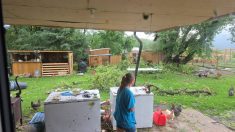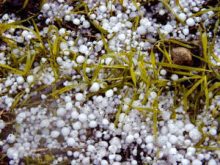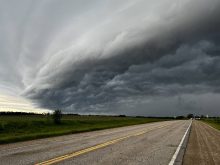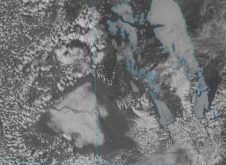I find it kind of interesting, and maybe a little weird, that in the last issue I indicated that this issue would be about thunderstorms and hail, and then during the last week areas around Winnipeg experienced thunderstorms with hail — I even had some at my place. I think this week I should end by saying in our next issue, we’ll discuss what perfect late-spring and early-summer weather are like!
If you have spent any significant amount of time living on the Prairies, there is a good chance you have probably experienced a hailstorm. While hail can occur pretty much anywhere across North America, there are two main regions where the chances of experiencing a hailstorm are significantly higher. The first region is the central United States; the second region is the Canadian Prairies and in particular, Alberta.
Read Also

Thunderstorms and straight-line winds
Straight-line winds in thunderstorms can cause as much damage as a tornado and are next on our weather school list exploring how and why severe summer weather forms.
For those of you who routinely read my column, then you know I have a fair number of weather peeves. Well, I have another one and, you guessed it, it has to do with hail, or rather, the improper use of the term hail. Hail refers to the falling of ice from a cumulonimbus (thunderstorm) cloud. Ice pellets, snow pellets and graupel (a snowflake that has been coated in ice) are not hail and should not be called hail. These types of precipitation will often occur in the spring or late fall and are not associated with thunderstorms.
One of the first questions I get asked about hail is: can it be too warm for hail? The answer is “yes.” If the upper atmosphere is warm, then the freezing level in the atmosphere is very high up. If a thunderstorm does develop, and if hail forms in the storm, chances are that the hail will melt well before it ever reaches the ground. So the key ingredient for hail to form is to have plenty of cold air aloft and to make sure it is not too high off of the ground.
Most thunderstorms will produce hail; the question is whether or not the hail will grow large enough to make it to the ground without completely melting. As we have already discussed, a very low freezing level helps this happen, because the hailstone only has a short distance to fall through the relatively warm air. Another way to keep a hailstone from melting before it hits the ground is to start off with a really big hailstone! This is one of the main reasons Alberta sees so much hail (compared to everyone else in Canada). The topography of Alberta is such that while ground temperatures can be really warm, the freezing layer is not that high up relative to what it might be in Manitoba.
Now, here is where a second common misconception about thunderstorms and hail lies. To get really big hailstones you do not necessarily need a really tall (or high) thunderstorm.
Hail forms when a particle passes from the warm (liquid) part of the cloud into the cold (freezing) part of the cloud. When this occurs, any water on the particle freezes and you now have a small hailstone. Now, if that hailstone just kept going up toward the top of the thunderstorm, it wouldn’t accumulate much more ice and therefore it would remain small. For hailstones to get really big they must go back into the warm (liquid) section of the storm, pick up more water, then go back up into the cold section of the cloud so the water can freeze. Repeat this cycle a number of times and you can get some really big hailstones.
When it comes to hail, size really does matter! Pea-sized hail will do little if any damage to structures and plants, while golf ball-sized hailstones can literally destroy everything in their path. When it comes to measuring hailstone size, things become a little strange. That is, you don’t usually hear that the hail will be around 50 millimetres in diameter. Instead you hear that the hail was the size of a golf ball or an egg. Of all the things we measure in regards to weather, hail has by far the most descriptive measurements. The table shows some of the more common descriptive terms used for hail and the approximate size that hailstone would be.
To end off this week’s article: the biggest hailstone ever recorded fell in Nebraska in 2003 and measured seven inches in diameter (a softball is about 4.5 inches in diameter)! The heaviest hailstone ever recorded fell in Kansas and weighed in at 1.67 pounds. On a more global scale, in 1986, hailstones reportedly as heavy as 2.2 lbs. fell in Bangladesh. It has been estimated that hailstones this large hit the ground travelling at nearly 160 kilometres per hour! The storm in Bangladesh resulted in over 90 fatalities as a result of the hail.
The longest-lasting hailstorm ran 85 minutes and covered the ground to a depth of 46 cm! This is what happened in June 1959 in the town of Selden, Kansas.



















